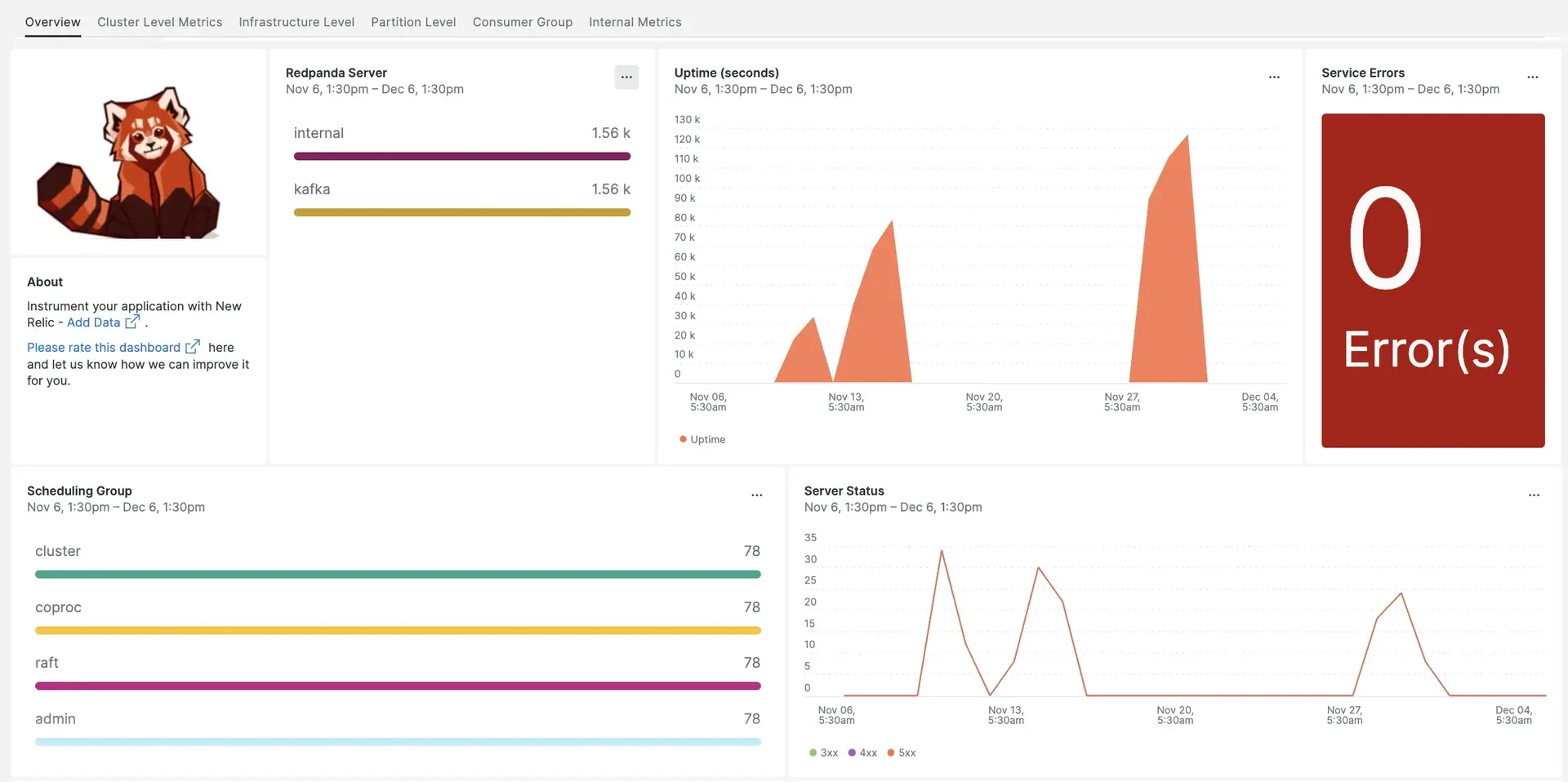Nossa integração RedPanda captura métricas em nível de cluster, dados sobre grupos de agendamento e detalhes sobre seus erros de serviço e tempo de operação e, em seguida, exibe esses dados em um pré-construído.

Depois de configurar o Redpanda com New Relic, seus dados serão exibidos em um dashboard, pronto para uso.
Conclua as etapas a seguir para instalar a integração:
Instalar o agente de infraestrutura
Para usar a integração do RedPanda, você precisa primeiro instalar o agente de infraestrutura no mesmo host. O agente de infraestrutura monitora o próprio host, enquanto a integração que você instalará na próxima etapa estende seu monitoramento com dados específicos do RedPanda.
Configurar integração
Crie um arquivo chamado
nri-prometheus-config.ymlem/etc/newrelic-infra/integrations.d.Adicione o trecho a seguir ao arquivo
nri-prometheus-config.ymlpara ativar a captura de dados do RedPanda. Certifique-se de editar o arquivo de configuração com suas informações:integrations:- name: nri-prometheusconfig:# When standalone is set to false, nri-prometheus requires an infrastructure agent to work and send data. Defaults to truestandalone: false# If using the infrastructure agent, emitters have to include infra-sdkemitters: infra-sdk# The name of your cluster. The name of your cluster must be consistent across New Relic products so the infrastructure agent and nri-prometheus can scrape data from the cluster.cluster_name: "YOUR_EXPORTER_NAME"targets:- description: Redpanda metrics are captured in the below urlsurls: ["http://localhost:9644/metrics", "http://localhost:9644/public_metrics"]# tls_config:# ca_file_path: "/etc/etcd/etcd-client-ca.crt"# cert_file_path: "/etc/etcd/etcd-client.crt"# key_file_path: "/etc/etcd/etcd-client.key"# Specifies whether or not the integration should run in verbose mode. Defaults to false.verbose: false# Specifies whether or not the integration should run in audit mode. Defaults to false.# Audit mode logs the uncompressed data sent to New Relic. Use this to log all data sent.# It does not include verbose mode. This can lead to a high log volume, use with care.audit: false# The HTTP client timeout when fetching data from endpoints. Defaults to "5s" if it's not set.# scrape_timeout: "5s"# Length in time to distribute the scraping from the endpoints. Default to "30s" if it's not set.scrape_duration: "5s"# Number of worker threads used for scraping targets.# For large clusters with many (>400) endpoints, slowly increase until scrape# time falls between the desired `scrape_duration`.# Increasing this value too much will result in huge memory consumption if too# many metrics are being scraped.# Default: 4# worker_threads: 4#Specifies whether or not the integration should skip TLS verification. Defaults to false.insecure_skip_verify: falsetimeout: 10s
Reinicie o agente do New Relic Infrastructure
Antes de começar a usar seus dados, reinicie o agente de infraestrutura.
O seguinte comando deve funcionar para a maioria dos sistemas:
$sudo systemctl restart newrelic-infra.serviceEncontre seus dados
Você pode escolher nosso modelo dashboard pré-construído chamado RedPanda para monitor a métrica do seu servidor Nextcloud. Siga estas etapas para usar nosso modelo dashboard pré-construído:
De one.newrelic.com, vá para a página + Integrations & Agents .
Clique em Dashboards.
Na barra de pesquisa, digite
RedPanda.O dashboard RedPanda deve aparecer. Clique nele para instalá-lo.
Seu dashboard Nextcloud é considerado um painel personalizado e pode ser encontrado na interface Dashboards. Para obter documentos sobre como usar e editar o painel, consulte nossos documentos dashboard .
Qual é o próximo?
Se quiser personalizar seu painel RedPanda, você pode aprender mais sobre como criar uma consulta NRQL e gerenciar seu painel na interface do New Relic :
- Introdução ao criador de consulta para criação de consultas básicas e avançadas.
- Introdução aos dashboards para personalizar seu dashboard e realizar diversas ações.
- Gerencie seu dashboard para ajustar o modo de exibição do dashboard ou para adicionar mais conteúdo ao seu dashboard.